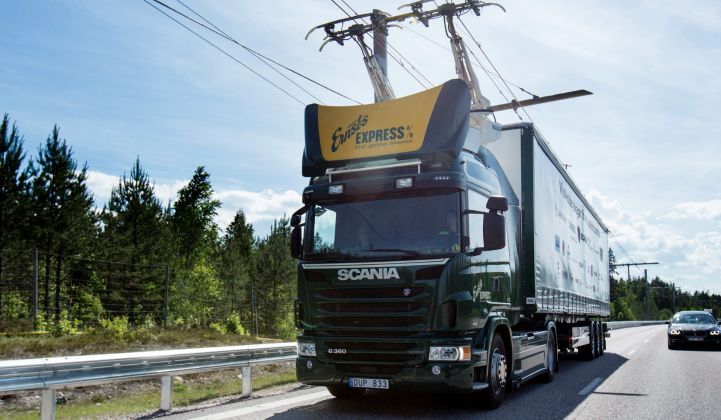Europe’s Nordic countries are resorting to a technology from 1880 in a bid to solve one of the latest challenges in vehicle electrification.
Sweden and Norway are both building overhead power systems, similar to those used in electric trams dating back 136 years, in order to assist with the electrification of heavy-duty vehicles that are hard to move with existing battery technology alone.
The current leader in overhead heavy-duty vehicle electrification is the Swedish truck maker Scania, which in June announced the opening of a two-kilometer e-highway in Gävle in mid-eastern Sweden.
Scania has adapted two of its G 360 4x2 hybrid trucks to draw power from overhead lines along the electrified stretch of the E16 motorway, a European highway that runs from Gävle in Sweden to Bergen in Norway and then, via ferry routes, to Scotland and Northern Ireland.
The trucks are equipped with a pantograph power collector mounted on the frame behind the cab, and can connect or disconnect freely from an overhead electric distribution system created by Siemens.
They operate as electric vehicles while on the electrified stretch of road, and as hybrid vehicles running on biofuel at other times.
The e-highway, backed private and public sector bodies including the Swedish Transport Administration, Gävleborg Regional Authority, the Swedish Energy Agency Authority and research and development company Vinnova, is part of a two-year test.
It is not clear if the concept will be extended across the country. In the meantime, however, neighboring Norway is making plans for highway electrification on a much grander scale.
The country, which already boasts the world’s most advanced electric vehicle market, is eyeing the outcome of the Swedish project to decide on how best to provide inductive charging for a 1,100-kilometer stretch of the E39, a highway running down western Norway to Denmark.
Officials are hoping to complete electrification of the route between Trondheim and Kristiansand by 2035, after launching a NOK 8 million (USD $1 million) pilot called "El in GO" last year.
According to reports earlier this year, officials have yet to decide on whether the technology will be overhead lines as in Sweden or an electrification system integrated into the road surface.
In any case, the plans being made by the Norwegian Roads Administration involve using renewable energy, including from solar, wind or wave generation, to help provide the estimated 1.5 terawatt-hours of electricity a year needed for full electrification of the route.
One of the challenges facing the project is how to provide electrification across the E39’s numerous bridges, including some that will replace existing ferry crossing and could be up to four or five kilometers long.
Nevertheless, Christina Bu, secretary general of the Norwegian EV Association, said the scheme would be a shot in the arm for Norway’s already advanced vehicle electrification program.
“I think it is really good that there are initiatives that look into how we can cut emissions from heavy transport too, like the example in Sweden,” she said. “Heavy transport is the really big challenge ahead, as it is expected to grow a lot more than private transport.”
Elsewhere, however, some have questioned whether tram-style electrification schemes are the right approach.
“Infrastructure investments move slowly and getting other automakers on board with a specific physical standard could be challenging,” said Colin McKerracher, manager for advanced transport insight at Bloomberg New Energy Finance.
“Falling battery costs and improved energy density will make applications like on-board range-extenders more attractive over the coming years.”
An alternative approach that might prove more viable is the one being adopted by Tevva Motors, which combines battery power with a small diesel engine to allow “unlimited operational range,” according to the company’s website.
Tevva is currently testing the technology, which can be retrofitted to existing vehicles, in three trucks on U.K. roads.
Scania is also pushing ahead with standard hybrid trucks, although currently these have an electric range of up to 2 kilometers and are primarily being commercialized for use in situations where engine noise could be a problem.



